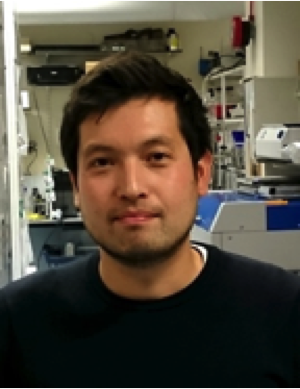Institute of Structural & Molecular Biology, Division of Biosciences, University College London, UK. The transcript cleavage factor paralogue TFS4 is a potent RNA polymerase inhibitor Nature Communications 8, 2017, 1914. doi:10.1038/s41467-017-02081-3 Thomas Fouqueau, Fabian Blombach, Ross Hartman, Alan CM Cheung, Mark J Young, Finn Werner
Cv
Thomas Fouqueau, 32 ans, a découvert le monde fascinant des archées pendant son stage de Master à l‘Université Aix-Marseille II, où il s’est intéressé plus particulièrement au processus de la transcription de l’ADN en ARN chez les archées. Pendant sa thèse, sous la direction du Prof. Michael Thomm (Universität Regensburg, Allemagne), il étudie le rôle d’un composant du centre actif de l’ARN polymérase, appelé « trigger loop », dans la sélection du substrat et de son implication sur le mécanisme catalytique de l'ARN polymérase des archées. Depuis 2013, il a intégré l’équipe du Prof. Finn Werner (University College London, Royaume-Uni) et poursuit ses recherches post-doctorales sur les mécanismes de régulation de l’expression génique chez les archées, notamment les mécanismes activés en réponse à certains stress cellulaires tels que l’infection virale ou la lésion de l’ADN cellulaire.
Contact
Thomas Fouqueau, PhD.
Research Associate
RNAP lab
Department of Structural and Molecular Biology (ISMB)
University College London (UCL)
Gower Street London, WC1E 6BT
Tel.: +44 20 7679 0477
https://sites.google.com/site/rnaplab/
Résumé de l'article
Archaea are unicellular prokaryotic organisms resembling Bacteria in term of morphology and metabolic diversity but with information processing machineries (transcription, translation, replication) more closely related to those of eukaryotes. RNA polymerase (RNAP) is a large multisubunit enzyme that carry out gene transcription in all living organisms. During transcription, transcript cleavage factor such archaeal TFS and eukaryotic TFIIS enhance the processivity and fidelity of RNAPs. The archaeon Sulfolobus solfataricus has four TFS paralogues. While TFS1 functions as a bona fide cleavage factor, we identified that the paralogous TFS4 evolved into a potent RNA polymerase inhibitor. TFS4 destabilises the TBP–TFB–RNAP pre-initiation complex and inhibits transcription initiation and elongation. All inhibitory activities are dependent on three lysine residues at the tip of the C-terminal zinc ribbon of TFS4; the inhibition likely involves an allosteric component and is mitigated by the basal transcription factor TFEα/β. A chimeric variant of yeast TFIIS and TFS4 inhibits RNAPII transcription, suggesting that the molecular basis of inhibition is conserved between archaea and eukaryotes. TFS4 expression in S. solfataricus is induced in response to infection with the Sulfolobus turreted icosahedral virus. Because archaeal viruses rely exclusively on the transcription machinery of the host cell for the synthesis of viral proteins, expression of TFS4 potentially inhibits virus replication in infected host cells. Our results reveal a compelling functional diversification of cleavage factors in archaea, and provide novel insights into transcription inhibition in the context of the host–virus relationship.




